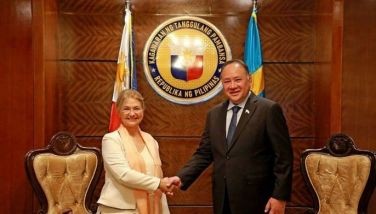Rome pilgrimage: Montecassino
CEBU, Philippines - In the early morning of October 18, we arrived in Rome, then went straight to our tour coach for the long distance drive to Montecassino, 130 km or 81 miles southeast of the Eternal City. We were a group of 48 pilgrims in the consortium 6-day tour by Land & Sky Travel and Delmar Travel & Tours, of Montecassino and San Giovanni Rotondo, ending in Rome for the canonization rites. Rev. Fr. Joselito "Junjun" Gutierrez of the lead agency was our Tour Leader/Spiritual Director, while I was the assigned Tour Escort of the 26 Delmar passengers.
We arrived at the mountaintop Benedictine Abbey towards noon with a guide waiting for us inside. Our bus parked some distance from the main "gate" where we climbed stone steps that felt like a 90-degree slope all the way up to the ancient entrance to the Oratory where St. Benedict - founder of western monasticism -- used to gather the monks for common prayers. The site used to be the pagan temple of Apollo. St. Benedict reused it and dedicated it to St. Martin, Bishop of Tours (France). At the midst of the tranquil garden is the riveting bronze sculpture depicting the death of St. Benedict, who, according to his first biographer St. Gregory the Great, died "standing, supported by some monks" right after he received the Holy Eucharist. This 1952 work is a gift from the German Chancellor Karl Adenauer.
After the first cloisters of the Oratory, we entered into a big courtyard with an ancient octagonal well at center, surrounded by Corinthian columns. Flanking the very wide flight of stairs linking this area to the covered terrace of the upper cloisters, are the huge marble statues of the holy twins: St. Benedict and his sister St. Scolastica who also founded a monastic order for women. Their mortal remains are in a bronze urn at the back of the High Altar in the Basilica. Devotees from all over the world come here to venerate the twins. In Latin script on a black marble scroll by the 15th century Abbot Della Noce is the touching memoriam: "St. Benedict and St. Scolastica were never separated in the spirit during their life nor are their bodies separated in their death." The tombs were not damaged by the World War II bombings as a bomb got lodged in front of the altar but did not explode.
Benedict of Norcia (Perugia) was the son of a Roman noble (480 - 547 AD) who got frustrated with the wanton lifestyle of his contemporaries. After an unsuccessful love affair that affected him deeply, he got out of Rome accompanied by his old nurse and settled in Enfide. He was in the company of some men who shared his values. Enfide is 40 miles from Rome in the Simbrucini Mountains. In these mountains, Benedict met a hermit monk named Romanus who guided him when he became a hermit in a cave at the side of the mountains for three years. His holiness and miracles attracted others who established monastic groups under his care. With the established monasteries were schools for children.
St. Benedict built the Abbey on Montecassino in 529 AD. The Lombards sacked it in 584 AD as the monks fled to Rome where they stayed in the next 100 years, while the remains of St. Benedict was transferred to Fleury, near Orleans (France). Distinguished monks revitalized the Order and re-established it in 718 AD. By 744 AD, due to a substantial land donation by a duke in Lombardy, Terra Sancti Benedicti (secular lands belonging to the abbey) was put in place under the sole supervision of the Head Abbot, answerable only to the Pope. The monastery became capital of a state that included the principality of Benevento in Lombardy, as well as the thriving coastal city-states of Naples, Gaeta and Amalfi. Saracens burned down the monastery & sacked it in 884 AD. Pope John XXII made the Montecassino church into a cathedral in 1321; then, an earthquake devastated it in 1349. Napoleon's troops sacked the Abbey in 1799 and it became a national monument after the dissolution of Italian monasteries in 1866.
As it was part of the Gustav Line - the German defense against the Allied invasion of Italy - the Abbey was the center of the Battle of Montecassino in January - May, 1944. American air raids totally destroyed the Abbey on February 15, 1944, killing women and children who sought sanctuary there. Fortunately, German officers Lt. Col. Julius Schlegel (a Catholic) and Capt. Maximilian Becker (a Protestant) of the Panzer Division of Herman Goering safely transferred to Rome some 1,400 precious manuscripts and documents, along with some other treasures, before the start of the defensive battle. The huge marble statue of St. Benedict that we see today near the stairs survived the bombings.
Pope Paul VI reconsecrated the Basilica on October 24, 1964 and named St. Benedict as the Patron Protector of Europe. St. Benedict died on March 21, 547 in Montecassino. His feast day is on July 11. The Abbey is now back as a working monastery and a pilgrimage center. It used to be a center of culture and the arts. One can appreciate its treasures in their museum. (FREEMAN)
- Latest


























